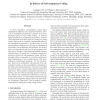Free Online Productivity Tools
i2Speak
i2Symbol
i2OCR
iTex2Img
iWeb2Print
iWeb2Shot
i2Type
iPdf2Split
iPdf2Merge
i2Bopomofo
i2Arabic
i2Style
i2Image
i2PDF
iLatex2Rtf
Sci2ools
ICCV
2011
IEEE
2011
IEEE
In Defense of Soft-assignment Coding
In object recognition, soft-assignment coding enjoys computational efficiency and conceptual simplicity. However, its classification performance is inferior to the newly developed sparse or local coding schemes. It would be highly desirable if its classification performance could become comparable to the state-of-the-art, leading to a coding scheme which perfectly combines computational efficiency and classification performance. To achieve this, we revisit soft-assignment coding from two key aspects: classification performance and probabilistic interpretation. For the first aspect, we argue that the inferiority of soft-assignment coding is due to its neglect of the underlying manifold structure of local features. To remedy this, we propose a simple modification to localize the soft-assignment coding, which surprisingly achieves comparable or even better performance than existing sparse or local coding schemes while maintaining its computational advantage. For the second aspect...
Related Content
| Added | 11 Dec 2011 |
| Updated | 11 Dec 2011 |
| Type | Journal |
| Year | 2011 |
| Where | ICCV |
| Authors | Lingqiao Liu, Lei Wang, Xinwang Liu |
Comments (0)

